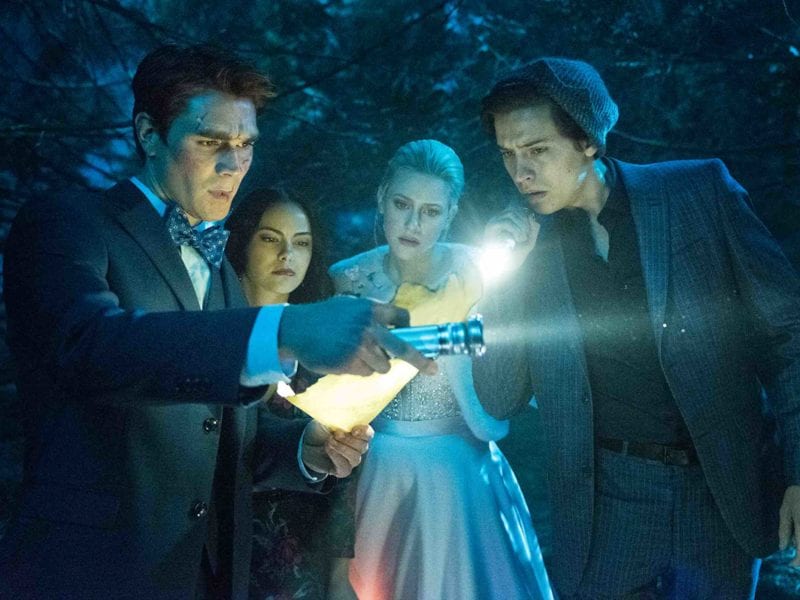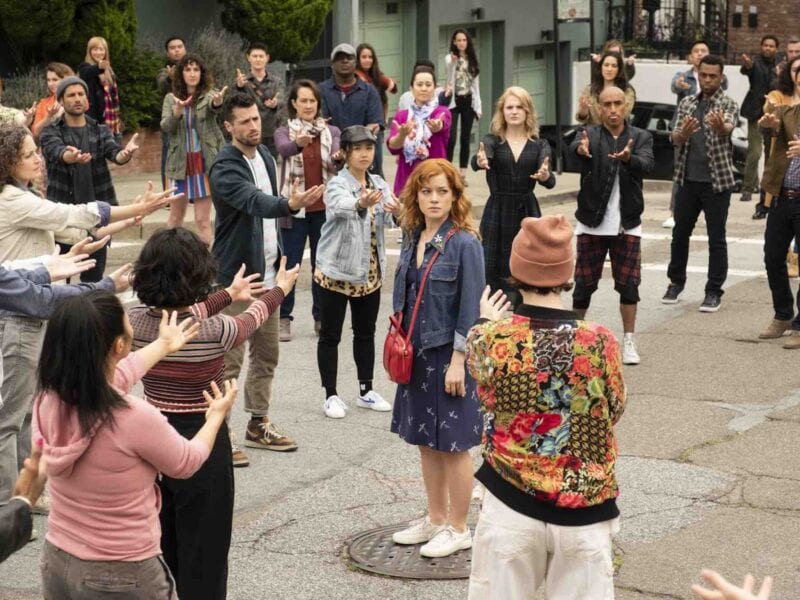
How Kylie Eaton’s ‘Dispel’ takes an honest look at addiction
For those who try to keep their eyes on best short film condenders, one of the hot condenders will make its free digital premiere at the end of August. Kylie Eaton came into the game swinging last year with her award-winning directorial debut 43 Quintillion. Now, her latest film Dispel takes on the tough topic of addiction in a different way: through the eyes of the addict’s young daughter.
Eris Baker (This is Us) takes on the role of Lizzie, a young girl who has to take on her mother’s addiction alone after her older brother moves out of their home. “Armed with the lessons of her favorite TV show Celeste Skygood, Lizzie battles to save her mother from the dark forces that have transformed her,” according to the official synopsis. Gina Torres (Suits, Firefly) takes on the role of Lizzie’s mother.
Lizzie’s desire to use her favorite TV show as her secret weapon is true to Eaton’s own childhood, as Eaton used fantasy as a means to take on bigger issues in her life when she was young. Dispel takes on the heavy topic of addiction in a new light, offering a different point of view on the uphill battle of recovery.
Dispel has already run the short film festival circuit, even scoring a spot at the LA Shorts International Film Festival. At Comicpalooza, Dispel won “Best Fantasy Short” during the film festival portion of the convention. Just like Eaton’s debut film, Dispel is causing a buzz on the festival circuit with good reason.
We were lucky enough to speak with Eaton herself about Dispel and the creative process behind the short.

Tell us about your history as a filmmaker. How did you start your journey?
After attending film school at Chapman University, I started work in post-production with a focus on editing. I began as a director for music videos, which is a great way to learn visual storytelling, constructing a narrative without dialogue or professional actors.
I was the main editor on 2017 short film, Girl Meets Roach, and learned the craft of directing from behind the scenes. I’ve always been a fan of sci-fi and fantasy, so I decided to create a few experimental shorts in this genre first, before moving onto wider narrative.
Who were your early influences?
Early in life, I was influenced by Peter Jackson, Tim Burton, Mimi Leder, and JJ Abrams, but most of all by Steven Spielberg. Telling stories through the eyes of a teenager, that can also resonate with adult viewers, is something Steven Speilberg does incredibly well.
I tried to achieve the same thing in my latest project, Dispel. When the film screened at Indy Shorts festival last week, a member of the audience said, “That was a great kids movie, but I also got a lot out of it.” That’s exactly what I was going for!
I’m also inspired by the way he can weave fantasy and magic into science fiction. I love Doctor Who on a similar level, which Neil Gaiman says has contributed to a “small golden age” of science fiction on TV. That’s the type of world I love to work in.

How did you find working on Dispel?
A lot of effort often goes into independent projects like Dispel, because you’re helping someone’s dream project come true. It was the middle of summer in Los Angeles and really hot, but the crew put their all into production. It was a very empowering experience. I’m proud that, together with the cast and crew, we were able to create something that has a deep story but also honours the science fantasy themes I love.
Where did the concept come from for Dispel?
I was thinking about stages in my life that were emotionally significant, such as when my two older siblings moved out. I wanted to explore that fear of being left behind or alone. This bond between siblings became a catalyst for everything that happens in the film, including the sci-fi elements.
Lizzie is dealing with her older brother leading, and so dives into fiction as an escape from her difficult situation at home. That’s what I did as a kid – I read a lot of books, watched a lot of movies, and completely immersed myself in those worlds. For me, fantasy is such an interesting way to explore mental health.
I think it’s important to find new ways of talking about these issues. In the case of Dispel, an alcoholic mother transforms into a fantastical monster as a way to show her sickness and suffering.
Tell us about your creative process.
When I come up with the idea for a project – because I write as well as direct – I’ll spend most of my time outlining the script,. I’d lie down on the couch, close my eyes and try to envision the film itself. I’ll also do research into the scientific concepts I’m trying to get across.
If it’s a film like Dispel, which pays homage to the classic sci-fi greats, I’ll also go back and research the original Star Trek and Doctor Who, etc. All to get a feel for that niche of pop culture. From there, it’s a pretty quick process when I actually put pen to paper and start writing the screenplay.
Once the screenplay is set, I start to look at it from a director’s point of view. I pull a lot of visual references from other movies, even those not sci-fi or fantasy. It’s then a matter of finding department heads I want to work with, discussing details with the costume designer, DP and others.
Next, I put out a casting call and work with actors to discover how their portrayal might shape my script. Characters and scenes are then fully developed, ready to shoot.

What tips do you have for new filmmakers?
One of the most frequently asked questions I get is from aspiring science fiction filmmakers: “I don’t have enough money to begin filming with all the visual effects. What would you suggest?”
I recommend that you do a proof of concept. Whether its one scene or a montage, then challenge yourself to tell a story that has a beginning, middle, and end in those 2-5 minutes.
Also, try to focus on the characters and narrative of your film. When working in sci-fi and fantasy, it’s easy to get distracted by the fun, flashy elements of a story. You’ll take a lot of the financial burden off the project by instead prioritising human relationships and behaviour. Shoot what you can in-camera.
You’re very hands-on with your projects. How hard is it wearing all the hats?
It’s difficult on both sides. Wearing all the hats is a challenge in terms of how much time you have to put in and splitting your focus. Not wearing all the hats can be equally challenging, as you need to find people that have a similar vision to you early in post-production, and be able to work together well.
The number one priority for me is to set yourself up as best you can in pre-production, then hand over activities when filming begins so you can focus on being the director – working with the actors, setting up a scene, planning a sequence of shots to cut together, and more.

What’s your next project?
I’m working on a sci-fi feature right now. Keep an eye out for more details coming soon.
Have you worked with mentors in the past? How would you recommend people go about finding them?
The Alliance of Women Directors has almost been like a mentor program for me. I’ve just completed a four month intensive workshop on directing, led by the founder of AWD, Jennifer Warren.
Learning from someone who has been in the industry for a while – who has worked on both sides as both an actor and director – gave me a lot of perspective. I also think that having a strong network of directors at a similar level to yourself is important – so you can bounce ideas off each other.
What’s the main mission in your filmmaking? What’s the one thing you want your viewers to experience when watching your movies?
I don’t want to box myself in, but I really enjoy any genre involving an altered reality, such as fantasy or sci-fi. Looking at real life through a distorted or altered lens is a great way to present truths in a way that’s easier to digest. Film can be used as a way of projecting our worries or desires onto a physical form, especially in a genre package.
I want to tell honest, emotional stories in this way. There’s also so much to unexplored in those worlds when it comes to women, such as mother-daughter relationships, sisterhood, and female friendships.

Can we expect to see any episodic television from you anytime soon?
I have no current plans. However, I love watching episodic television and think a lot of character development happens in this space. It has a huge influence on the work that I do.
What’s your five-year plan?
I’ll still be making films, writing, and directing. I’m always taking steps to work at a higher level of skill and production with each new project.
What filmmakers should be on our radar?
Female directors are finally starting to be recognized and hired at higher levels, and it’s exciting to watch their careers develop. Keep an eye on the Alliance of Women Directors. It’s a fantastic organisation, filled with talented people.

What’s your favorite film of all time and what did you learn from it?
I have to say Star Wars: A New Hope. I learned a lot about the hero’s journey, character development, and structure. You have to keep in mind that Star Wars wasn’t too large a production at first. However, the crew showed a lot of ingenuity. They fused everyday items, practical effects, and miniatures into this massive worldbuilding project.
I tried to do something similar with Dispel by designing trading cards around character history and hiding Easter eggs in the set of Lizie’s room. Most of the planets, organizations, and characters imagined in the Dispel universe are never mentioned on screen – but they still exist behind the scenes.
… Also, I learned that a score can really affect a movie!
—
Follow the movie now! Instagram Twitter
Audiences can tune into DISPEL’s online premiere here, via YouTube.







